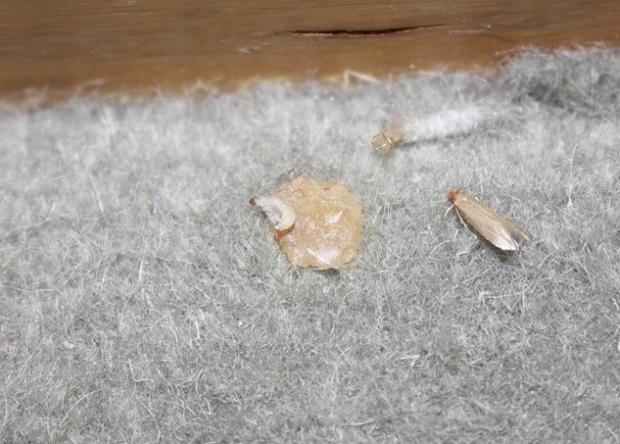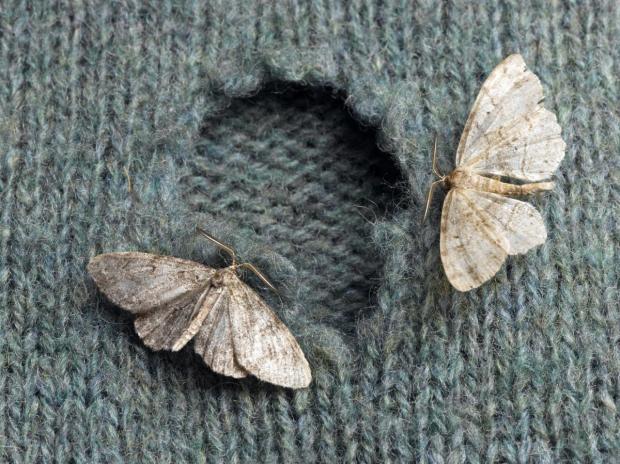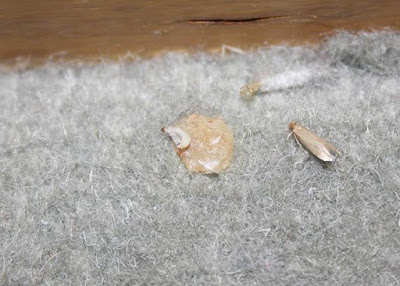IN spring, a young moth’s fancy turns to love – so lock up your jumpers. Don’t put them in a dingy closet, though. With temperatures rising and the moth breeding season under way, pregnant females are seeking out dark nooks and crannies to lay their eggs: preferably, ones filled with tasty woollies for the hatching larvae to munch through.
This alarming process is happening right now in a wardrobe near you – and disturbingly, Tineola bisselliella (to give the insect its Sunday name) seems to be growing ever more rampant. According to The Herald’s fashion editor Eva Arrighi, the pests – which appear partial to fine silk, angora and cashmere – are creating intense fear and loathing within the rag trade. Former Vogue editor Alexandra Shulman famously declared war on the tiny creatures – they are only half-an-inch across – after her designer wardrobe was attacked and Arrighi now fears for her own vintage coat collection after discovering that the blighters had been silently chomping through the carpets beneath her household furniture.
Insecticide sales are soaring and it’s not only domestic properties that are at risk. Earlier this month it was reported that carpets in the High Court of Glasgow had been treated for moth infestation.
Meanwhile, stately homes are on high alert. At Newhailes house, Musselburgh, the biggest moth control programme ever mounted by the National Trust for Scotland (NTS) is under way after a sharp increase in insect activity was detected there. As NTS preventive conservator Mel Houston explains, the exercise is designed to nip the problem in the bud before the moth population explodes.
READ MORE: Hundreds of climate change activists 'pretend to die' in Glasgow museum
She attributes the insects’ UK-wide expansion to central heating, the popularity of luxury fabrics and perhaps lower housekeeping standards than our forebears, and the Newhailes anti-moth programme includes lots of “very unglamorous cleaning, cleaning and more cleaning”. “Moths don’t like being disturbed,” explains Houston, “and if you keep hoovering, you hoover up the eggs and larvae and reduce the population.”
The NTS has also created a mini-ice age within the 17th-century country house by installing two huge freezers cold enough to kill adult insects, larvae and eggs. Priceless historic carpets, curtains and even sofas are being systematically removed from their settings, wrapped and then chilled to minus-35C before being returned to the deep-cleaned rooms, which will then be carefully monitored to guard against re-infestation.
Glasgow Museums, which owns textiles and costumes dating back to the year 1100, also adopts the freezer method: the Burrell’s entire tapestry collection has been put through the service’s own industrial-sized chiller as a precaution. And as preventive conservator David Thomson points out, this isn’t a new technique. “In the old days, anyone with fur coats would take them to the furrier to be kept in cold storage during the warm summer months.”

Clothes moths have been around for a long time – though no-one seems sure whether they are native to these shores or were imported from warmer climes, perhaps on the tunic of a Roman soldier or even a Bronze Age warrior. We do know that they are an age-old nuisance. In 1590, Elizabeth I engaged eight men to spend a full day beating Windsor Castle’s furs to rid them of moths. But in modern times, says Thomson, the problem became considerably more troublesome around 10 years ago – perhaps, he speculates, following the ban on naphthalene-based insecticides such as mothballs.
This isn’t just a UK problem. In some American museums, where millions of dollars are spent on pest control, people are banned from bringing overcoats into buildings. Could museums of the future institute a polyester clothing rule, I wonder.
“Shell suits only? We haven’t got there yet,” laughs Thomson, though he points out that many of us are unwittingly carrying larvae around on our clothes. “Moths are part of the natural world,” he says. “They can be brought in by visitors so we’re always going to be up against it. Most museums have decided that trying to achieve zero moths is not practical or economical so we’re just managing the problem as well as we can to minimise the risk to our collections.”
The recent “dramatic increase” in moth numbers means Thomson now devotes much of his working life to the threat and, like Houston, he says scrupulous cleaning is crucial.
“Dust, which is largely skin particles and clothing fibres, accumulates 1,000 times faster in a museum context because of the large number of people in our buildings,” he points out.
“So we need to make sure our housekeeping is based on good old hoovering, and that display systems don’t create dust traps.
“We are refurbishing the Burrell and it’s really important that our redisplays of the tapestries are safe from infestation. One of the ways we’re doing that is trying to ensure our buildings are scrupulously cleanable, and some of the design work for the new Burrell is based around eliminating the possibility of dust traps.”
READ MORE: Hundreds of climate change activists 'pretend to die' in Glasgow museum
Stored objects are regularly checked, quarantined and treated as necessary and as Thomson points out, taxidermy is particularly vulnerable. Moth larvae live on keratin, the protein which makes up skin, hair, nails and feathers. (Birds’ nests, incidentally, are often infested and before there were clothes, carpets or even humans, animal carcases may have been the primary hosts.)
Every so often, says Thomson, one of Kelvingrove’s much-loved stuffed birds or mammals has to be removed from display and placed in the freezer. “The natural history conservator knows how to look for tell-tale signs,” he adds. “Most obviously, they might spot an adult moth exiting from its feathers. That means it has pupated there. If you look closely you can sometimes see the larvae or its faeces, which is called frass.”
In domestic settings, the signs are similar. “The most obvious one is flying adult moths,” says Thomson. “If eggs have been laid on your favourite jumper, you won’t see them because they are too small for the human eye but if you notice holes and look closer, you may see caterpillars which have hatched out and increased in size after eating [your jumper]. They’re white with a brown head.”
Icky as all this sounds, Thomson freely admits to having moths in his own home – which like most old tenements has plenty of the floorboard and skirting gaps that can harbour the insects. In fact, he seems almost grateful for these domestic close encounters, for helping him get to know his professional enemy.
Back at Newhailes, Mel Houston says she and her colleagues are deliberately “open about washing our dirty linen in public, because we are doing the best we can and we know that a lot of our visitors have moth problems themselves. In fact, we’ve been running tours to let people see how we are cleaning, how we are treating the problem and looking after our properties and collections”.
A keen environmentalist who is also a member of the Buglife conservation trust, Houston is conscious of the apparent irony of targeting the insects at a time when many moth species are under threat. Just last week, Scottish Natural Heritage (SNH) reported that moth numbers have declined by 46% over the past 25 years, with moorland species particularly affected – a trend attributed to global warming, and changes in land management and habitats.
Clothes moths, however, were not covered in the report and SNH trends and indicators analyst Simon Foster is heartened that the NTS is raising awareness of the many varieties of valuable moths and butterflies. Moths, he says, are “much maligned because of one or two troublesome species” and while he understands the need to control the clothes-munching variety, he points out that overall, moths are “a really important group for pollinating plants” and “a key part of Scotland’s natural environment”.
A glimpse of a flitting Burnet or Cinnabar should convince anyone that these beautiful creatures are welcome within our midst. Nor is the clothes moth itself an unlovely specimen, with its delicate wings and fluttering flight pattern. Its offspring, however, are destructive and while banishing them from our homes completely seems unlikely (“You’ll always find one that you never got to,” says Mel Houston), spring is a good time to try. “If you can prevent them mating and laying eggs, you’ve reduced the cycle,” says David Thomson.
Fashion editor Eva Arrighi is also on the case. Having spent “a fortune” on moth-killing treatments, she now conducts nightly patrols of her home, waiting for a winged invader to flit into her path. “My kids think I’ve gone mad and I’m prone to agree,” she says. “But I think you have to be obsessive to deal with moths.”

Moths, says Mel Houston, are "secretive" beasties, which hide themselves away and only emerge to look for a mate or a suitable woolly birthing place. By the time you see them, they've already done their worst since it's the larvae that munch through your clothes and carpets before emerging as adult moths.
To prevent further damage:
Hoover frequently, particularly under furniture (moths prefer to lay their eggs in dark, undisturbed places).
Use pheromone traps to monitor moth activity in your home.
Wash clothes before storing and ideally place in sealed plastic bags.
Our fashion editor Eva Arrighi recommends placing lavender bags or cedar balls in clothes drawers, though she suggests the latter should be sanded to release the aroma.
If infestation is suspected, wash garments at the highest temperaturethe fabric will stand.
For woollens and delicates, borrow a tip from our conservation experts by wrapping in plastic bags and placing in your freezer for a week or two to kill moths, eggs and larvae.
Chemical moth-killers are effective when used according to manufacturers' instructions. For serious infestations, consider engaging the services of a professional pest-control company, which will be licensed to use fumigation techniques.
source:https://www.heraldscotland.com/news/17602920.kelvingrove-animals-are-deep-frozen-to-eliminate-moths/
Kelvingrove animals are deep frozen to eliminate moths
 Reviewed by animalword
on
avril 28, 2019
Rating:
Reviewed by animalword
on
avril 28, 2019
Rating:
 Reviewed by animalword
on
avril 28, 2019
Rating:
Reviewed by animalword
on
avril 28, 2019
Rating:


Aucun commentaire: